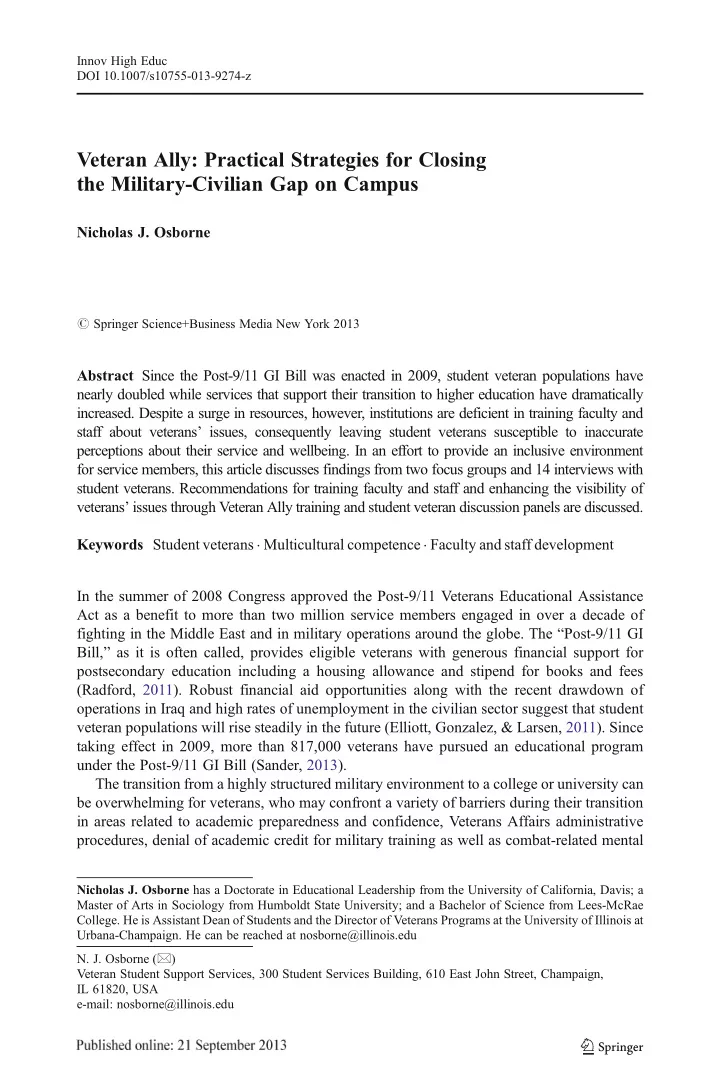

Innov High Educ DOI 10.1007/s10755-013-9274-z Veteran Ally: Practical Strategies for Closing the Military-Civilian Gap on Campus Nicholas J. Osborne # Springer Science+Business Media New York 2013 Abstract Since the Post-9/11 GI Bill was enacted in 2009, student veteran populations have nearly doubled while services that support their transition to higher education have dramatically increased. Despite a surge in resources, however, institutions are deficient in training faculty and staff about veterans ’ issues, consequently leaving student veterans susceptible to inaccurate perceptions about their service and wellbeing. In an effort to provide an inclusive environment for service members, this article discusses findings from two focus groups and 14 interviews with student veterans. Recommendations for training faculty and staff and enhancing the visibility of veterans ’ issues through Veteran Ally training and student veteran discussion panels are discussed. Keywords Student veterans . Multicultural competence . Faculty and staff development In the summer of 2008 Congress approved the Post-9/11 Veterans Educational Assistance Act as a benefit to more than two million service members engaged in over a decade of fighting in the Middle East and in military operations around the globe. The “ Post-9/11 GI Bill, ” as it is often called, provides eligible veterans with generous financial support for postsecondary education including a housing allowance and stipend for books and fees (Radford, 2011). Robust financial aid opportunities along with the recent drawdown of operations in Iraq and high rates of unemployment in the civilian sector suggest that student veteran populations will rise steadily in the future (Elliott, Gonzalez, & Larsen, 2011). Since taking effect in 2009, more than 817,000 veterans have pursued an educational program under the Post-9/11 GI Bill (Sander, 2013). The transition from a highly structured military environment to a college or university can be overwhelming for veterans, who may confront a variety of barriers during their transition in areas related to academic preparedness and confidence, Veterans Affairs administrative procedures, denial of academic credit for military training as well as combat-related mental Nicholas J. Osborne has a Doctorate in Educational Leadership from the University of California, Davis; a Master of Arts in Sociology from Humboldt State University; and a Bachelor of Science from Lees-McRae College. He is Assistant Dean of Students and the Director of Veterans Programs at the University of Illinois at Urbana-Champaign. He can be reached at nosborne@illinois.edu N. J. Osborne ( * ) Veteran Student Support Services, 300 Student Services Building, 610 East John Street, Champaign, IL 61820, USA e-mail: nosborne@illinois.edu
Innov High Educ and physical disabilities (Ackerman, DiRamio, & Mitchell, 2009; Armstrong, Best, & Domenici, 2005; Hassan et al., 2010). These stressors are made more complex by veterans ’ perceptions that faculty and staff members do not understand military culture or the challenges veterans face when transitioning to an academic setting (Berrett, 2011; Cook & Kim, 2009). To serve veterans effectively many institutions have implemented specific programs or an independent veterans office to mitigate the stressors associated with transitioning to a civilian higher education environment (Herrmann, Raybeck, & Wilson, 2008; Lokken, Pfeffer, McAuley, & Strong, 2009). Despite an increase in student service programs, fewer than half of the schools that offer these resources provide training to faculty and staff designed to enhance understanding about military culture and veterans ’ unique needs and transitional issues (O ’ Herrin, 2011). In July 2012, the American Council on Education released a report based on a survey of 700 institutions that was designed to assess the diverse range of campus programs and services offered to veterans. The report, From Soldier to Student II (McBain, Kim, Cook, & Snead, 2012), found that initiatives designed to assist veterans with their transition to higher education have increased dramatically over the past three years since the Post-9/11 GI Bill took effect. However, the report also concluded that institutions are deficient in training faculty and staff about military culture and the complexities surrounding veterans ’ diverse service experiences. The Complex Layers of Military Service Many veterans today have persevered through incredibly arduous circumstances although as a group veterans are difficult to characterize (Sander, 2012). Exposure to demanding conditions including the threat of serious injury or death, numerous deployments, and separation from their families are only some of the stressors to which veterans may be exposed during their time in the service (Basham, 2008). Some research suggests that as many as 50% of post-9/11 veterans have experienced an emotionally distressing event while on active duty (Pew Research Center, 2011). Upon leaving the military, veterans may confront multiple physical, cognitive, and emotional challenges during their transition to civilian life (Elliott et al, 2011). However, although consideration of these points should not be minimized, not all veterans view their service as traumatic (DiRamio & Jarvis, 2011). Prior to their enrollment in higher education, many veterans have lived throughout the world and have immersed themselves in different cultures, most recently including Iraq and Afghanistan. Additionally, they may have served and worked in various regions of the U.S. and have interacted with a diverse military workforce spanning numerous socioeconomic strata (Hassan et al., 2010). The fast-paced and technical training the military provides instills its members with a strong sense of discipline and teamwork while offering them a variety of opportunities to apply their skills in real-world situations (DiRamio & Jarvis, 2011). Before pursuing a degree many veterans have mastered foreign languages, worked with foreign governments, operated and maintained expensive and high tech equipment, managed others, performed life-saving medical duties, and applied critical leadership and decision-making skills in tense situations. As Hassan et al. (2010) explained, Most veterans today have had many broad, unique, positive, and insightful developmental experiences during their military service. Many of these veterans have survived, endured, and excelled in artificial and real-world situations, leaving them both resilient and self-confident (p. 31).
Recommend
More recommend